Blog
Astronomy at the
Edge of the Sky
26 September 2015
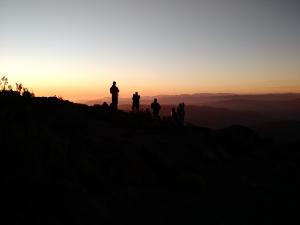 Brian Koberlein
Brian KoberleinIn the mountains of Chile I experienced the brightest night sky I’ve ever seen. We normally seek dark skies for astronomy, but here the sky is so dark and clear that it seems ablaze with stars. The Milky Way overhead is so brilliant it seems to cast shadows. It is a sight so humbling it’s difficult to put into words.
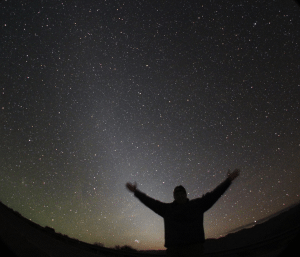 Peter Detterline
Peter DetterlineChile resides in a “sweet spot” for modern astronomy. Steady winds from the Pacific ensure skies relatively free from turbulence, and Chile’s arid mountain range provides plenty of crystal clear nights. Combined with the Chilean government’s efforts to limit light pollution, you have the makings of excellent astronomy. While professional astronomy has been active in Chile for decades, the recent surge of “big astronomy” projects such as the Atacama Large Millimeter/submillimeter Array (ALMA) has led to a rapid growth of astronomy in the region.
There’s also been interest in promoting these efforts to the general public, which is why I had the opportunity to visit the region. Along with eight others I was selected to be part of a National Science Foundation project known as the Astronomy in Chile Educator Ambassador Program (ACEAP). The goal of the project is to bring educators to Chile to get a first-hand look at several observatories so that they can tell people about their experience. Saying yes to the offer was one of the easiest decisions I’ve ever made.
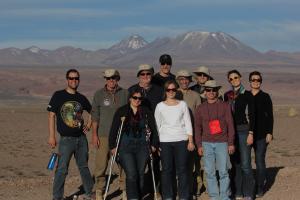 Tim Spuck
Tim SpuckOur trip took us from the capital city of Santiago to La Serena (near Gemini and CTIO), then north to the Atacama where ALMA is located. One of the things we noticed early on was a strong interest in amateur astronomy. Santiago’s surrounding mountains ensure that the city can be troubled by smog at times, but it also means you don’t have to travel far from the city to reach dark skies. As a result, there are several “tourist” observatories in the region.
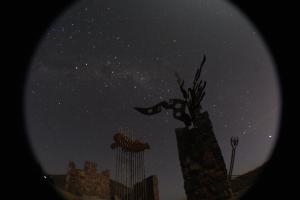 Mike Prokosch
Mike ProkoschThese observatories tend to integrate artwork and astronomy in fascinating ways, whether it’s the inviting space of Observatorio Astronomico Andio, or the astronomically-aligned Cerro Mayu Observatory. They also aren’t limited to metropolitan regions. In the small town of San Pedro in the heart of the Atacama desert you could find street vendors selling tours of the night sky.
Of course it’s the big telescopes that dominate in Chile. By 2020 more than two thirds of the world’s astronomical infrastructure will be in Chile. Four our trip we focused on just three sites: Gemini South and SOAR on Cerro Pachón outside of La Serena, CTIO on nearby Cerro Tololo, and ALMA in the Atacama desert near San Pedro.
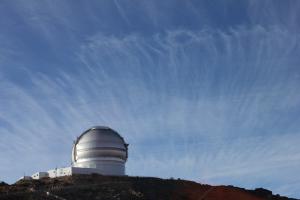 Peter Detterline
Peter Detterline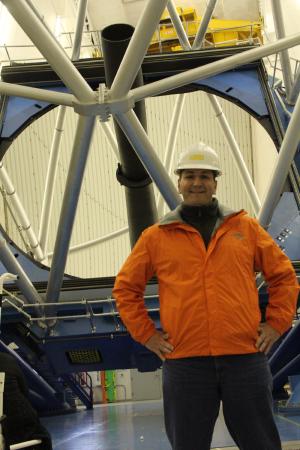 Sarah Komperud
Sarah KomperudGemini South is an 8-meter telescope that has been in operation since 2000. It uses adaptive optics to gather clear images in the visible and near infrared. It’s name derives from the fact that it has a northern twin on Mauna Kea in Hawaii. As Gemini South maps the southern skies, Gemini North maps the northern skies. Together they cover almost the entire sky. Their specialty is observing the spectra of astronomical objects using both long-slit spectroscopy and integral field spectroscopy. These allow us to study the rotational motion of extended objects such as galaxies and nebulae.
While we only spent a short time on Cerro Pachón, we got to spend two nights on Cerro Tololo. The temperatures were unseasonably mild for early winter, and the night skies were perfect.
Cerro Tololo is dominated by the 4-meter Victor M. Blanco telescope, built in the early 1970s. A main research project of the Blanco observatory is the Dark Energy Survey, which looks for supernovae to study the dynamics and large scale structure of the universe. Near the Blanco telescope are several telescopes that are part of the Small and Medium Research Telescope System (SMARTS). One project that utilizes these telescopes is the CTIO Parallax Investigation, which searches for dim dwarf stars in our solar neighborhood.
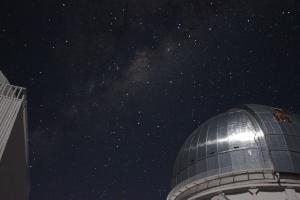 Renae Kerrigan
Renae KerriganSince then dozens of telescopes have been built on the site, including a cluster of smaller telescopes that form the “mushroom farm.” Many of these are tenent telescopes that rent space on the site.
It was on Cerro Tololo that we really had the opportunity to get a feel for what these remote observatories are like. We weren’t simply given a tour and sent on our way, but resided with the astronomers and workers. The observatory is remote, so it’s removed from the bustle of everyday life. It has an exquisite beauty that moves some to compose music about the experience.
 Jim O’Leary
Jim O’LearyOf course the observatory most of us looked forward to visiting was the Atacama Large Millimeter/submillimeter Array (ALMA). ALMA is a microwave radio observatory located in the remote Atacama desert. In order to observe such small wavelengths, ALMA was built on the Chajnantor plateau about 5000 meters (16,000 feet) above sea level.
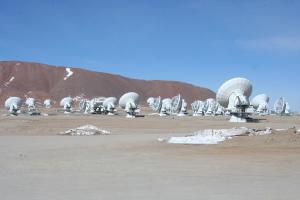 Mike Prokosch
Mike ProkoschALMA consists of more than 60 12-meter antennas as well as 12 7-meter antennas. The 7-meter antennas are designed to be closely spaced, forming the Atacama Compact Array (ACA). Since the antennas use interferometry to create images of the sky, the ACA creates a wide sky view, while the larger array of 12-meter antennas allows us to focus in on particular objects. The antennas can be moved to different locations to allow for different scales and resolutions.
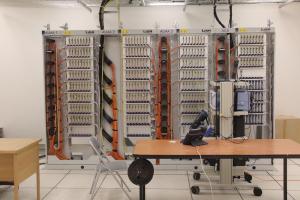 Tim Spuck
Tim SpuckThe engineering of ALMA is incredibly ambitious. In order to combine signals from the antennas, a supercomputing correlator had to be built on the plateau. It is the highest altitude supercomputer on the planet. The correlator not only has to account for the arrangement of the antennas, but also the orientation of the Earth relative to the target object. As the Earth rotates, the effective separations of the antennas relative to the target change, and the correlator has to account for this in its calculations.
 Peter Detterline
Peter DetterlineWhile it was amazing to see some of Chile’s best observatories, what I really gained from the experience was how much modern astronomy is a human endeavor. While we often talk about breakthrough discoveries, or the amazing engineering of modern observatories, much of the work is done behind the scenes. People have to design and manufacture these observatories, and they have to be maintained and supported in order for the science to get done. Machinists, programmers, groundskeepers and security officers all play a necessary role.
There’s also the political machinations necessary for international collaborations. A large observatory such as ALMA is too much for one country to undertake. So ALMA is a collaboration between the United States (NRAO), Europe (ESO), East Asia (NAOJ) and the Republic of Chile. Its coordination has been likened to the United Nations.
And that’s the direction big science is taking. It’s only by working together that we can solve the unanswered questions of the universe.